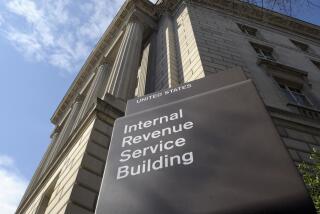IRS Computer System Threatens Chaos in 2000
- Share via
WASHINGTON — The Internal Revenue Service is launching a massive effort to forestall a breakdown of the income tax system when the year 2000 arrives and its computers, as now programmed, will be unable to read the date correctly, IRS officials said in interviews.
If the agency cannot quickly revise millions of lines of obscure software code, computer systems that manage tax data on every working American will throw the government’s financial operations into chaos. The problem threatens to result in “the generation of millions of erroneous notices, refunds, bills, interest calculations, taxpayer account adjustments, accounting transactions and financing reports,” according to a recent IRS report to Congress.
Computers throughout government and private industry face the same problem as the IRS: They assume that the first two digits of every year are “19,” and so they use only two more digits to designate the year. Thus they would interpret “00” not as 2000 but as 1900.
The problem may sound trivial, but government and private computer experts say solving it is anything but. By some estimates, the federal government alone will have to spend $30 billion over the next two years to adjust its computer software, while private businesses will have to spend far more.
The risks at the IRS are unusually high because its computer software is so old and so much of the tax system depends on dates. And the stakes are especially great; a computer meltdown at the IRS would ripple through the rest of the government and through the economy.
“A failure would mean a major disabling of the Internal Revenue Service,” said Arthur Gross, the agency’s new computer chief, who described in an interview the agency’s battle plan to avoid such a calamity.
Success is anything but guaranteed, however, because of the size and complexity of the problem. Gross acknowledged that the agency had “fallen behind the curve” in getting the problem fixed, and not even an act of Congress can postpone the deadline.
“It is a challenge,” Gross said.
The IRS will not know the full scope of the challenge until early next year. So far, Gross said, the agency has fully surveyed only one of its four groups of software.
In that one group alone, it concluded that it would take 1,800 staff years of labor to convert the software by Jan. 1, 1999, when tax forms will contain so many references to the year 2000 that the conversion will have to be complete. That’s 900 people working full time for the next two years. Ultimately, Gross said, the additional three software groups could increase the workload by about half.
Outside experts say the federal government in general has been dangerously late in recognizing the century date problem and will have to scramble to avoid major problems.
The Social Security Administration is credited with facing up to the problem earliest, starting in 1989. The fact that it will have taken that agency 10 years to prepare for the conversion raises questions about whether agencies such as the IRS can get ready in only two.
The state of California established a Project Year 2000 task force last January to address similar computer problems facing state government.
The effort to recode millions of lines of programming was expected to cost about $50 million. Now, however, officials believe that cost will rise.
Ron Ridderbusch, deputy director of the state Department of Information Technology, said a cost estimate will be determined in December.
Although some departments are already seeing computer problems caused by the date correction, Ridderbusch said, California is far ahead of most states in seeking a solution. “Compared to a lot of organizations, we’ve really moved out in front of the problem,” he said. “There’s a lot of interest in using our work as a model.”
The origins of this time bomb can be traced back several decades to computer punch cards, which could store only limited amounts of data. Years were easily abbreviated to two digits--the year 2000 seemed far away then--to save storage space.
The practice continued through much of the 1980s, when computer memory was still expensive and at a premium. In many cases, software makers never expected that their products would be around in the next century.
“The IRS should be very concerned,” said Kevin Schick, an expert on century date conversion and the research director of The Gartner Group, a Connecticut-based software consulting firm that has estimated a government-wide cost of up to $30 billion.
“This could shake American confidence in the tax system,” Schick said. “The issue isn’t how much it will cost to fix the problem but how much it will cost if we don’t fix it.”
The seeming absurdity of the problem has meant that it has not attracted much high-level political attention in Washington, according to Lanny J. Davis, an attorney with the Washington law firm Patton Boggs.
“There is a lot of embarrassment on this issue,” said Davis, who predicts that many computer users will ultimately hold software and computer companies legally liable for the cost of the problem. “A lot of people are in denial.”
But IRS officials are taking the issue very seriously. Gross said the agency is assigning its top management experts to the problem. “This is the highest priority I have,” he said.
The federal government and the overall economy depend on smooth operations at the IRS, which collects and processes more than $1 trillion annually. For example, a major glitch in issuing refund checks, which injected about $123 billion into the economy between April and June of this year, could knock the American economy on its heels.
In outlining the problem, Gross said that the IRS had surveyed its most important software group, which is operated by mainframe computers and contains the so-called master file. That group has data on every taxpayer and processes the tax returns filed each year.
The survey indicated that 62 million lines of software must be recoded for the master file system. In some cases, the mainframes and their associated operating software at the IRS’ 10 service centers across the nation are so old that they can not be reprogrammed, and the hardware will have to be junked.
Of the agency’s three other software groups, IRS officials have not even surveyed the networks of minicomputers that exchange data with tax agencies in the 50 states. Similarly, the agency has not examined its microcomputer systems that help upload data into its master files. Nor has it examined its commercially purchased software systems, some of which are so old that vendors no longer provide support.
“Until we complete the inventory we will not know the scope of our problem,” Gross said.
Ultimately, Gross estimated, the IRS may find it needs to recode about 100 million lines of software. The agency plans to fix about 20% of its mainframe software by next February, giving it a basis to make a better estimate of exactly how big a job it still faces.
IRS operations are more dependent on correctly identifying dates than virtually any other agency, since income, taxes, deductions, exemptions, refunds and almost every other element of the tax system depend on the date.
“The entire structure of the tax system is built around time,” Gross said.
The IRS has some of the oldest computer software in the federal government, much of it written in computer languages that have fallen into disuse years ago. Because of the older software, the IRS can not use many of the tools that are being developed to automate the search and conversion work.
The agency is spending $45 million in the current fiscal year on the problem. The total cost of the project is not yet known. Private contractors will do about 40% of the work.
Rep. Steve Horn (R-Long Beach), chairman of the House Government Reform and Oversight subcommittee, which has led a scrutiny of the issue, said the IRS was late in realizing the size of its problem, though other agencies are doing far worse.
Horn’s subcommittee last week issued a so-called report card on government agencies’ response to the century date problem. The Treasury Department, where the IRS is located, got a C. By contrast, the Social Security Administration was given an A. But, Horn said, the Energy, Transportation and Labor departments, which have not yet even appointed someone to manage the conversion, were all given Fs.
Virtually all agencies, the survey found, are only in the early planning stages for the effort. In some cases, agencies had not even started working on a conversion plan until contacted by the subcommittee. Horn charged that the Office of Management and Budget had failed to coordinate the government’s response to the problem.
John Koskinen, deputy director of OMB, said the Clinton administration established an interagency task for century date conversion a year ago. In general, he said, the government was doing as well as private corporations.
“We early on brought awareness of the issue to the agencies,” Koskinen said. “Our approach to this is to make the agencies aware, share responses of agencies so we don’t duplicate efforts and hold agencies accountable.”
But Horn says OMB is moving too slowly even now and has delayed responding to a report on the issue requested by Congress.
“The clock is ticking,” Horn said, “whether we like it or not.”
More to Read
Inside the business of entertainment
The Wide Shot brings you news, analysis and insights on everything from streaming wars to production — and what it all means for the future.
You may occasionally receive promotional content from the Los Angeles Times.











